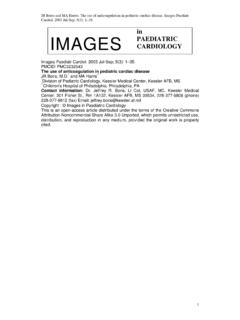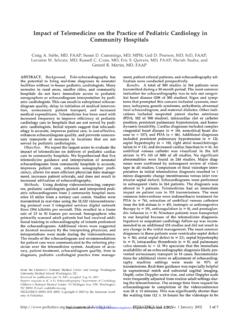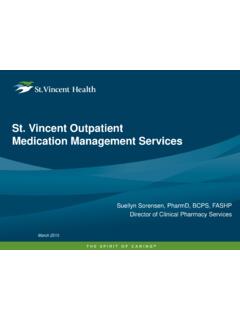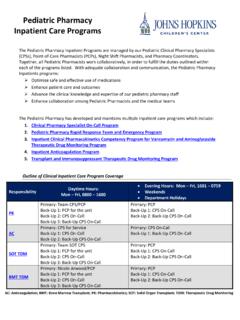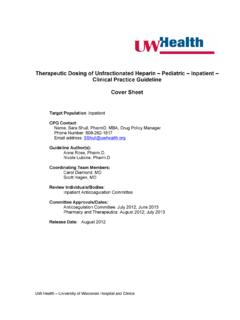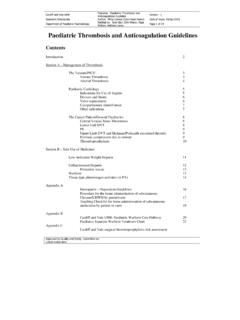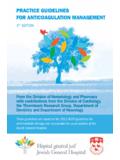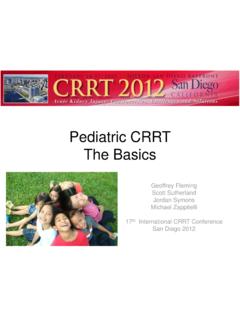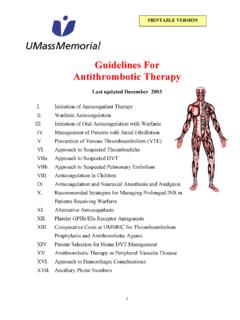Transcription of Anticoagulation with Warfarin - PCICS
1 Anticoagulation with Warfarin Loren Brown, BSN, RN, CCRN Clinical Nursing Educator, Cardiovascular Catheterization Lab Children s Hospital Boston Boston, Massachusetts Introduction: Many adults with congenital heart defects need to take anticoagulants. Common reasons for this type of treatment include prosthetic heart valve replacements, atrial arrhythmias, previous surgeries such as the Fontan operation, or other diagnoses where blood flow is turbulent due to narrow vessels, aneurysms, poor ejection or artificial devices. Anticoagulants slow blood clotting, preventing complications like blood clots forming on artificial valves, valve obstruction and blood clots traveling to the brain causing a stroke. Lesions: (Monagle, 2004, 2008) Indications/Goal Ranges Indication INR Goal Range DVT/PE 2-3 Prosthetic heart valves Aortic position 2-3 Prosthetic heart valves Mitral position Fontan Pulmonary Hypertension DVT Prophylaxis Cardiomyopathy 2-3 Kawasaki Disease 2-3 Atrial Fibrillation 2-3 Critical Thinking Points: Initial Response is usually with 24 hours after administration Peak Anticoagulation response 72 to 96 hr Duration of action of a single dose is 2-5 days Half life: Following a single Warfarin dose, the terminal half-life is about 1 week with a mean effective half-life of 40 hr (range, 20 to 60 hr).
2 (Prod Info COUMADIN(R) oral tablets, intravenous injection, 2010) Diagnostic Evaluation: INR- international normalized ratio (Ultimately this means that no matter how or where the lab is drawn it can be compared to another INR.) Al l people, regardless of Anticoagulation status, have a baseline INR around 1. Many centers draw a baseline INR and CBC before initial dose of anticoagulant. Treatment: Dosing is calculated over 7 days ( total WEEKLY dose). Adjustments are made by increasing or decreasing the weekly dose between 5-20%. Initial dose: o Loading dose is generally unnecessary. Theoretical reasons for beginning treatment with the average maintenance dose of 5 mg daily Usually results in an INR of after 4 or 5 days. o When a rapid effect is required, heparin should be given concurrently with Warfarin for 4 days.
3 O Loading dose: Warfarin dosing may be separated into initial and maintenance phases INR response is monitored frequently until a stable dose-response relationship is obtained. Once stable INR, the frequency of INR testing is reduce. Anticoagulant effect is observed within 2 to 7 days after beginning oral Warfarin . Guidelines when using a Loading dose (Children s Hospital Boston Formulary, Boston, Massachusetts): o Loading Dose Day 1 1. Give mg/kg (maximum mg/kg) up to a maximum of 15 mg per dose a. The dose is a routine dose. b. The higher end of loading dose ( ) may be considered when prompt elevation in INR desired and the patient s INR can be monitored very closely (usually on a daily basis). Most often this loading dose is used in patients who have had cardiac surgery for implantation of mechanical heart valves.
4 2. A loading dose lower than should be considered in patients with Fontan physiology, liver disease, decreased vitamin K intake and/or who are known slow metabolizers. 3. If patient was previously on Warfarin , start with home dose (or 10%-20% above home dose if INR less than ). o Loading Dose Days 2-7 1. Check INR in the morning; use each result to plan that evening s Warfarin dose: In the patient with baseline normal INR/PT, normal liver functions and who is not on medication interacting with Warfarin , may check INR on days 3, 4, 5 and 7 or at clinician s discretion 2. A reasonable method of adjusting Warfarin disease according to INR is as follows: If INR is , repeat the initial loading dose* If INR is , reduce the initial loading dose by 50% If INR is 2-3, reduce the initial loading dose by 50% If INR is 3-4, reduce the initial loading dose by 25% If INR is , hold dose, check INR following day then resume Warfarin at 50% of previous dose If INR > , hold until INR < then resume Warfarin at 50% of previous dose If INR > , hold and check INR daily, when INR <5, restart at 25% less than previous dose or at discretion of primary clinician.
5 3. Experienced clinicians sometimes increase the designated initial loading dose 25-50% if the response to the chosen loading dose is very slow ( , little or no response after two doses). This maneuver shortens the time to therapeutic Anticoagulation but increases the risk of overshooting target. 4. In the patient whose baseline physiology and metabolism are stable, the dose on Day 8 of therapy can be calculated by dividing the total dose over the first week by 7, and one can proceed to recommendations for Long-Term Monitoring. o Long Term Monitoring 1. Routinely monitoring of INR once every 4-6 weeks in patients 2. Stable INR 3. No clinical indications for more frequent monitoring ( , a. Started antibiotics b. Started on new medication known to interact with Warfarin c. Symptoms of bleeding o Guidelines for adjustment of Warfarin dose if INR outside of Anticoagulation goal 1.)
6 For maintaining INRs between and If INR is , Check for compliance, if compliant, increase maintenance dose by 20% If INR is , increase maintenance dose by 10% If INR is 2-3, no change If INR is , decrease dose by 10% If INR is , decrease dose by 20% If INR > , hold one dose, then restart 20% lower the previous dose* If INR >5, hold and check INR daily, when INR < , restart at 25% less than the previous dose or at discretion of the primary clinician. * 2. For maintaining INRs between and If INR is , Check for compliance, if compliant, increase maintenance dose by 20% If INR is , increase maintenance dose by 10% If INR is , no change If INR is , decrease dose by 10% If INR is , decrease dose by 20% If INR >5, hold one dose, then restart 20% lower than previous dose* *Depending on the reason for Anticoagulation and the perceived greater risk (risk of bleed versus risk of thrombus) dose reduction may be the preferred method of management over holding a dose to avoid a possible sub therapeutic level/ thrombus.
7 3. Additional guidelines a. When the INR is above the therapeutic range but <5, and the patient is asymptomatic (no clinically significant bleeding) and reversal is not required for surgical intervention, the dose of Warfarin can be reduced or the next dose omitted and resumed (at a lower dose) when the INR approaches the desired range. b. If the INR is between 5 and 9 and the patient is not bleeding and has no risk factors that predispose to bleeding, the next 1 or 2 doses of Warfarin can be omitted and Warfarin reinstated at a lower dose when the INR falls into the therapeutic range. Alternatively, the next dose of Warfarin may be omitted and vitamin K1 (1 to mg) given orally. This approach should be used if the patient is at increased risk of bleeding. c. When more rapid reversal is required to allow urgent surgery or dental extraction, vitamin K1 can be given orally in a dose of 2 to 5 mg, anticipating reduction of the INR within 24 hours.
8 An additional dose of 1 or 2 mg vitamin K can be given if the INR remains high after 24 hours. d. If the INR is 9 but clinically significant bleeding has not occurred, vitamin K1, 3 to 5 mg, should be given orally, anticipating that the INR will fall within 24 to 48 hours. The INR should be monitored closely and vitamin K repeated as necessary. e. When rapid reversal of Anticoagulation is required because of serious bleeding or major Warfarin overdose ( , INR 20), vitamin K1 should be given by slow intravenous infusion in a dose of 10 mg, supplemented with transfusion of fresh plasma or prothrombin complex concentrate, according to the urgency of the situation. It may be necessary to give additional doses of vitamin K1 every 12 hours.
9 F. In cases of life-threatening bleeding or serious Warfarin overdose, prothrombin complex concentrate replacement therapy is indicated, supplemented with 10 mg of vitamin K1 by slow intravenous infusion; this can be repeated, according to the INR. If Warfarin is to be resumed after administration of high doses of vitamin K, then heparin can be given until the effects of vitamin K have been reversed and the patient again becomes responsive to Warfarin . Associated Complications: Risk of bleeding Teratogenic effects on fetus if mother is on Warfarin during first trimester of pregnancy Special Considerations: Subtherapeutic INRs: Inquire about missed doses or recent dose changes of existing medications, diet and exercise changes (increased exercise, or healthy dietary habits can lower an INR), new medications, herbal supplements or green tea consumption.
10 Anecdotal resources indicate that marijuana use will lower INR (Potential Interactions - Alternative Therapies and Warfarin : Potential Interactions of Herbs with Warfarin ) Supratherapeutic INRs: Inquire about missed doses that have been caught up ( two doses in <24 hour period), new medications or recent dose changes of existing medications, illness that affect appetite (sore throat, nausea/vomiting etc) and alcohol consumption. INR values are affected with many different drugs; antibiotics are the largest group of medications that will raise an INR. Managing practitioners should have INR checked 2 -3 days after beginning a course of therapy to evaluate for elevation and potential dose adjustment and a repeat INR towards the end of the course for patients with an INR increase. Patients who have a low intake of vitamin K have been found to have more fluctuation in their INR.
